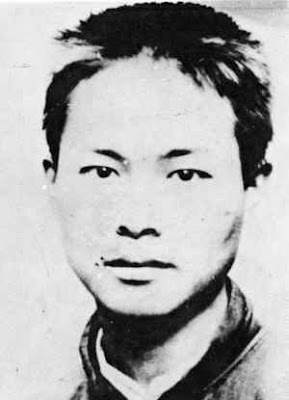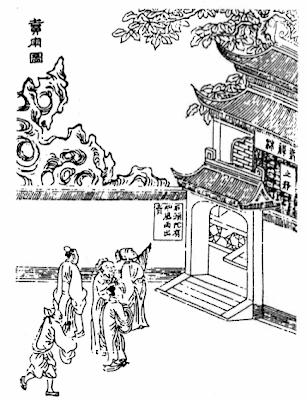Yang Zao 楊早 "Culture Heroes of the 1990s: the Cases of Chen Yinke and Gu Zhun." In Dai Jinhua, ed.,
Writing Culture Heroes 書寫文化英雄.
(NB, I mistook the author of this article for Dai Jinhua in
my last post on it)
Prefatory remarks and "Looking Back at the 1980s"
Prefatory remarks
Yang Zao points to the vastly increasing number of references to the most famous intellectual figures in Chinese periodicals -- the "culture heroes." Examples of "first rank" heroes are Chen Yinke, Wang Guowei, Wu Mi, Qian Zhongshu, Qian Mu, and Zai Hongming. There's also a "second rank" that includes folks like Gu Zhun, Lao She, Lin Zhao, Yu Luoke and Li Jiufeng. Besides the relative fame and influence of the "ranks," Yang Zao alludes to a difference in their trajectory towards their current places as cultural icons (my term; doesn't it translate "culture hero" well? More to come on that.).
Chen Yinke, master of 10+ languages
Rank one icons represent famous scholars from before 1949 whose names were forgotten for 30-plus years. Only in the 1980s did they begin to receive recognition again, and only in the 1990s did scholars begin to appreciate their work again, and by the mid 90s they had become popular cultural icons (大眾歌頌的文化偶像; here 'icon' is the explicit term). Second rank fellows (no women are mentioned here!) like Gu Zhun follow a different track -- they are figures within the general scope of Chinese Marxist pioneers, but they were covered up for political reasons and so had to be re-discovered.
But for all these types of thinkers, we see a common general pattern: in a three stage process, these thinkers went from beleagured or totally suppressed, to being seen as bastions of independent thinking, and finally to become powerful symbols of resistance. Along the way, the very basic sense of who they were and what their lives mean evolved -- in some cases it was completely remolded. Yang Zao proposes that recognizing the rich layers of contemporary portraits of these 'cultural icons' helps us establish the topology 圖景 (not a word I'm terribly familiar or comfortable with yet) of 20th century "senses of the essence of knowledge" 知識精英 (that sounds like a boilerplate preface ending -- it's not clear if that means anything yet).
Looking Back at the 1980s.
Yang gives us a very interesting overview of some major Chinese journals and the 'cultural icons' who became major topics.
Going back to the December 1988 issue of
Chinese Culture 中國文化 we can see quotes from Chen Yinke and Qian Zhongshu (Qian said: 東海西海,心理攸同;南學北學,道術未裂) that advance a conservative point against those pushing for westernization. The scholar making this point, Liu Mengxi went on to write a set of articles about Chen Yinke, which shows that Chen had become a major topic for the journal. Also
Reading 讀書 magazine, from its renewal in 1992, took as major topics Chen Yinke and Qian Zhongshu. Yang's effort here is evidently to show a relationship between the recurrence and character of scholarship about these cultural icons -- the way writers focused on the icon's personalities, especially -- a relationship between this phenomena and the general malaise within humanities scholarship after the June 4 massacres at Tiananmen Square.
In a longer discussion, Yang considers the magazine
Scholars 學人 which launched in 1991, which attempts to flesh out this relationship. The period between the mid 1920s and the mid 1930s was selected as a "golden age" in which more Chinese scholars had managed to achieve more than in any other period. The focus on the character of these scholars is bound to have been a huge influence on the general direction of 1990s thought. In all the articles on all the writers in Scholars magazine, there is a pervasive focus on what is said to be a "pure" 純 "history of the art of learning" 學術史. And yet, it was clear enough that this choice of topic and the attitude toward the topic was at least in part a reaction to 1989 that sought to find a new, less political role for intellectuals. A major figure here is Chen Pingyuan, who later in the magazine
The East 東方 published an essay on "the fates and the choices" 命運以及選擇 of humanities intellectuals 文人. It wasn't just the massacre that made us lose our sense of self 自我, says Chen. We are looking for what Vaclav Havel 哈維爾 calls for in his essay "The power of the powerless" : to prefer the "art of study" over politics; to prefer the private over the public; and to prefer the elevated over the popular. The goal is to gain some self-confidence again in our field by standing independently in these areas. Xu Youyu, another scholars, had a similar list of priorities for humanists of the 1990s:
- bring back Chinese studies 國學
- return to Marxism's view of human nature 人性.
- Science and Tech.
- Modern social science methods.
- Focus on the "spirit" of the humanities 人文精神的闡釋.
As the 1990s started, Xu advocated #1 even more to fill the "gaps" that had opened up. The end result was a large number of articles that searched for the key foundational features of great thinkers'
personalities 人格. [A long editor's note at this point praises Yang, calling this attention to the personage of the scholar a modern version of the attitude Yan Hui, Confucius' favorite student. This must be the voice of Professor Dai!]
Countercurrent:
Yang end's with what Yang takes to be a totally dissimilar point of view, commencing with
The East 東方 in 1993. An opening salvo in the magazine complains of the new "demoralization" 痞子化 of intellectuals. That Zhou Zuoren and other writers of what
Scholars called "the golden age" were considered to at least have the appearance of 'immoral fellows' 痞子 suggests the blanket cynicism that has evolved in this particular journal. In this space, however, writers more often thought up alternative histories: what if the May Fourth movement had turned out differently? In this way, even the cynics seem productive agents in this debate about humanities in China.
Read more...
















































